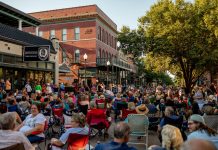From an abandoned street to one of the most known streets in St. Louis, Cherokee Street has become the center for Latino businesses and a fusion of cultures on several blocks. The vision of a family has been the guide to creating Cherokee Street into the growing community of Latino businesses on this revived street.

Rafael Dominguez opened Latino Americana in 1990, a small tortilla store that was the first Latino business to open on Cherokee Street.
In 1980, at the age of 15, Dominguez and his family arrived in Chicago, where he learned how to work as a butcher.
By 1989, Dominguez was offered a job at La Tropicana in St. Louis, the only Mexican store in the city at the time.
Dominguez took on the offer to have a new beginning in a new city after battling addiction. Once he moved to St Louis, he worked two jobs, and by 1989, he saved $5,000 to open his store.
“There were many clothing stores, and it was an American shopping center at the time. Back then only Americans went there,” he said, describing Cherokee Street in the early ‘90s. “There were some gangs, many young people with addictions, and prostitution began in the street. And who came to save the commercial street? The Hispanic commercial businesses.”
A few years later, other Latino businesses began to open on Cherokee Street.
“By 2000, there were many Hispanic businesses, and the crime began to leave and so did the prostitution,” Dominguez said.
While many of the first Hispanic businesses are not around anymore, some of them are still standing.
Over the years, Dominguez was able to buy the building where Latino Americana stands and acquire other buildings along Cherokee Street. As more Latino businesses began to open, he would rent these buildings to the newcomers.
La Vallesana was one of the businesses renting from Dominguez. Located across from Latino Americana on 2801 Cherokee St., La Vallesana welcomes visitors with a phrase on the outside wall that says, “La Esquina de sabor” (the corner of flavor). Owner Hilario Vargas opened La Vallesana in 2002 as an ice cream shop.
“The owner felt that it was a good area … it was heavily populated with Hispanic people,” Abigail Vargas, La Vallesana’s manager, said.
La Vallesana opened in the summer. When the winter came, the owner started selling tacos and tortas, eventually expanding to more cuisine.
After four years of renting the building from Dominguez, Vargas bought the lot.
Over time, as more customers came, La Vallesana needed more space. By 2011, the small white building was demolished, and a new building was built.
Today, La Vallesana still serves the dishes and desserts they’ve had since opening.
“We still get a lot of new people that come from seeing like us on Facebook or the internet or people recommend us to them. So, we still get a lot of hype, (and) our regulars that came from the very beginning,” Abigail Vargas said.
Another business that has become a staple of Mexican cuisine on Cherokee Street is Diana’s Bakery, named after the daughter of Ana and Refugio Vazquez, Diana.
“When we started the business, you’d barely see a few Latinos, now you see Latinos at any time and everywhere. Here, on Cherokee, is where most Latinos come to do their shopping because they know that the stores, restaurants, and bakeries are here,” Ana Vazquez said.
Diana’s Bakery first opened its doors in 2006 in a building the Vazquezes rented from

Dominguez. Ana Vazquez remembers selling cakes from her home and building a clientele. After a year, Diana’s Bakery moved to 2843 Cherokee St. where it stands to this day.
From flans to tres leches and conchas, Diana’s Bakery presents a wide variety of Mexican pastries.
Aside from being one of the most recognized Latino businesses on Cherokee Street, Diana’s Bakery celebrates traditional customs from Mexico through the bakery. From making pan de muertos for the Day of the Dead in November to roscas in early January.
In addition to offering a variety of cuisine, Cherokee Street also offers shopping from stores such as Carrillo’s Western Wear. Carrillo’s Western Wear opened on Cherokee Street in 2004.
When she first opened, Carrillo’s owner Maria Sarabia describes the street as abandoned with few stores. She had heavy concerns about having a business on Cherokee Street at the time.
“It was a risk to have a business here, truly, because there was a lot of vandalism. That’s why the street was destroyed all because of the vandalism,” Sarabia said.
The hope that the street would get better was a push for Carrillo’s to open and offer vaquero clothing to the public.
Vaquero clothing pieces are similar to “cowboy” clothing that comes from Mexico and is usually used for dances and to go to clubs. When Carrillo’s opened, it was a block and a half from Casa Loma, a ballroom that hosted Hispanic and American dances.
The ballroom hosted a special night for Hispanics and many people from outside of St. Louis would go to Casa Loma and Carrillo’s, as well, to get vaquero clothing.
In addition to longtime storefronts, new businesses on Cherokee have been able to flourish in the last few years.
La Manganita Cuisine opened five years ago at 2812 Cherokee St. Manager Manny Garcia describes its cuisine as Michoacán style with tacos al pastor, homemade tortillas, mole and more. Everything is done from scratch.
“It’s what makes us different, our flavor of spice, and that it’s made from scratch,” Garcia said.
Walking on Cherokee Street, you will find Garcia standing outside of La Manganita with a trompo (vertical rotisserie) of al pastor, ready to cut and serve. This dedication to food has kept and brought American and Hispanic diners returning for more.
In great part, Garcia’s success comes from his experience in American and Mexican restaurants and his passion to create innovative dishes.
“When I arrived (to St. Louis), only Latino Americana existed. It was a small store, there was El Torito and another small store,” Garcia said.
Now Cherokee Street has a variety of bakeries, stores, hair salons and even more new businesses opening.

Garcia has lived in St. Louis for the last 24 years, and he even worked for Dominguez, the previous owner of Latino Americana. Now Garcia orders bulk food from Dominguez, who now owns a wholesale food company called La Bodega.
“Now the difference is that I order the food from him (Rafael) … it was a very nice encounter to see each other after a long time,” Garcia said
As for Latino Americana, Carlos Dominguez, brother of Rafael, has been managing the store since 2000.
As the years have gone by, the community has grown, and so has Latino Americana.
“They can come to pay their electric or gas bills and especially the service in Spanish. Something they can’t find in other big stores,” Carlos Dominguez said.
Today, Carlos Dominguez runs Latino Americana and even rents buildings, just like what his brother did.
Sueño Latino offers Honduran food such as baleadas, pollo con taladas and plátanos fritos. Co-owner Jesus Eduardo Nuñez says that the restaurant opened three years ago during the pandemic.
After seeing a post online that the spot on 2818 Cherokee St. was vacant, Núñez, his brother and their mother decided to jump on the chance and open their restaurant.
“We were open for three weeks to the public and then we had to close. It was hard, truly very hard,” Núñez said.
However, with patience and the community’s support, Sueño Latino reopened. While Sueño Latino is not a Mexican restaurant, it partakes in Mexican celebrations such as Cinco de Mayo.
“We prepare fast food, nachos, Honduran tacos, pollos con taladas … We try to prepare fast food to make because it’s a crazy day,” Núñez said.
Today, the Latino community on Cherokee Street has grown from a small tortilla store into a community of businesses that keep growing and offering more every year. Its celebration of Cinco De Mayo attracts approximately 50,000 every year.
“Before, we were a lot of temporary workers … but now a lot of the people that live here are in construction, in companies, restaurants, and we are a big strength for the city of St. Louis,” Carlos Dominguez said.
To find more information, go to cherokeestreet.com.



